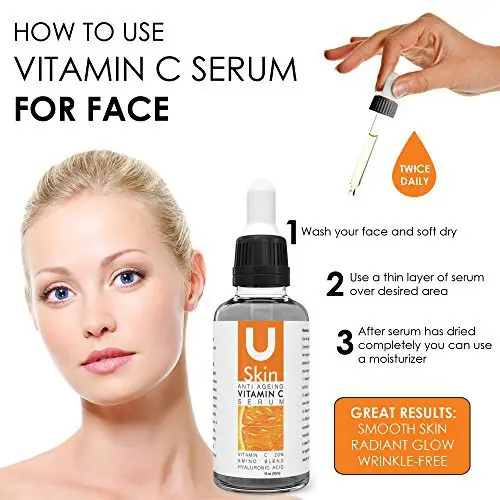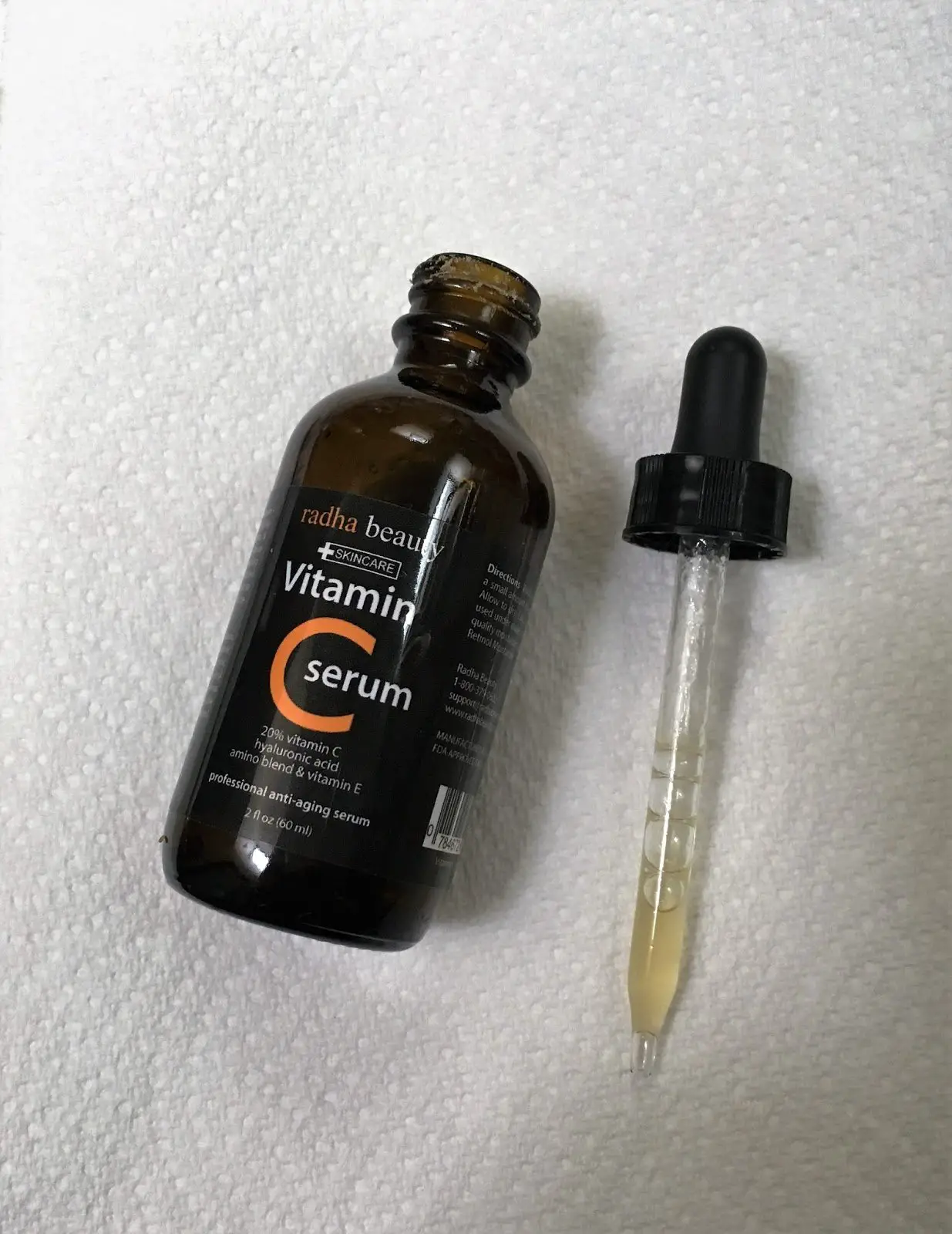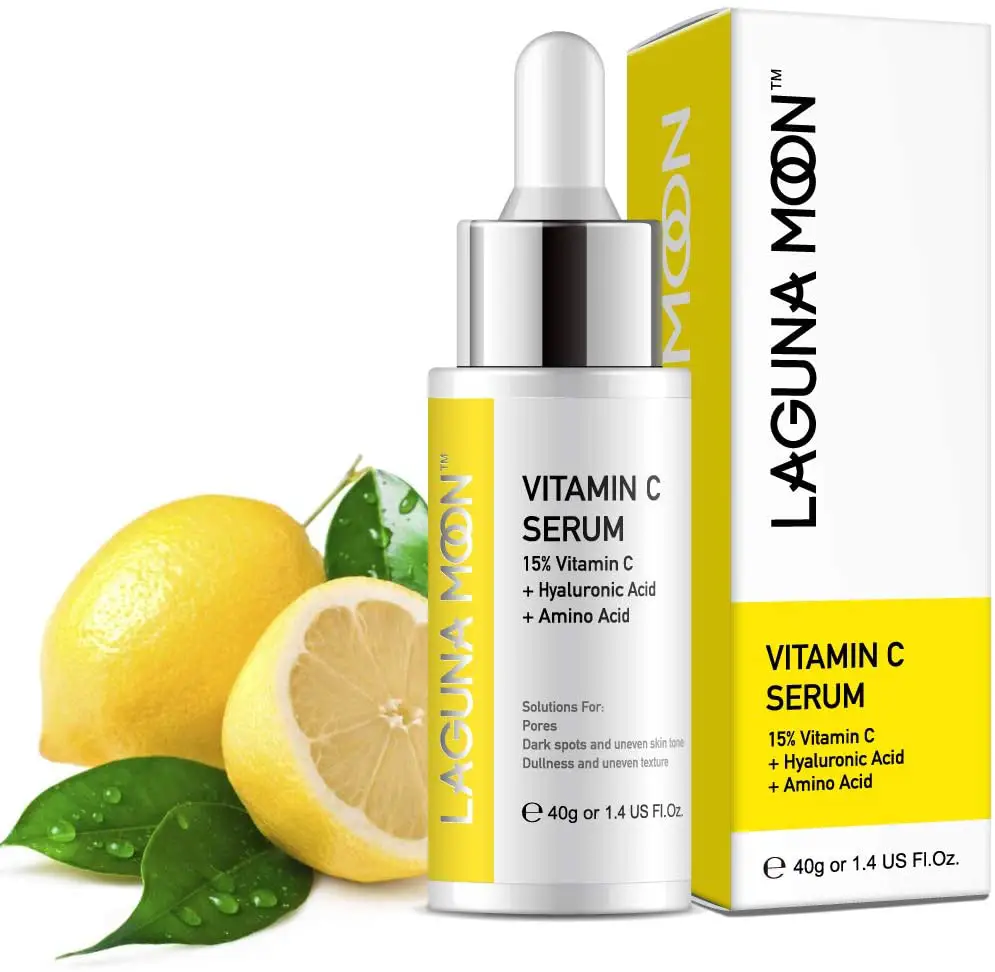Option : Apply Them 30 Minutes Apart
Your final alternative is to apply your vitamin C serum and acid 30 minutes apart.
Personally, I always take this approach whenever I’m using products that have a gap of more than about 1.0 to 2.0 in pH levels.
So while I wouldn’t wait in between an AHA and L-ascorbic acid, for example, I’d do so with a higher-pH vitamin C derivative, such as:
- Ascorbyl glucoside: pH 5.0-7.0
- Ethyl ascorbic acid: pH 4.0-5.5
- Magnesium ascorbyl phosphate: pH 6.0-7.0
- Sodium ascorbyl phosphate: pH 6.0-7.0
The same goes for vitamin C formulas that are anhydrous , which don’t have a pH level at all.
But waitdidn’t I just mention that acidifying the skin could enhance the conversion of vitamin C derivatives into active vitamin C?
Yes, but here’s something else to consider. If you layer one right on top of the other, the vitamin C derivative is likely to dilute or raise the pH of the acidwhich would reduce its effectiveness. This study looked at the absorption of AHAs at pH 3.0 versus pH 7.0, and found that the higher the pH, the less the skin absorbs.
In other words, if getting the most out of your acid exfoliant is important to you, incorporate a waiting period to give it time to work, before applying your vitamin C derivative on top.
In this case, you’d apply your acid first, wait 30 minutes, and then follow up with your vitamin C derivative, hydrators and sunscreen. You don’t need to wait after your vitamin C!
What Is Vitamin C
According to Robinson, vitamin C is an essential nutrient required for the growth and repair of tissues in all parts of the body, including the skin, but we cannot produce it on our own. The powerful antioxidant is found naturally in fruits and vegetables and commonly produced synthetically in skincare products, such as moisturizers, toners, and, most often, serums.
“It is important to note that vitamin C has both active and inactive forms, Guanche explains. “Depending on the skin care formulation, applying vitamin C can do absolutely nothing or can work as a powerful antioxidant.” The first form of vitamin C worth mentioning is the pure form, L-ascorbic acid. Herrmann says this is the most biologically active and well-studied form of vitamin C, but there are also several vitamin C derivatives, such as sodium ascorbyl phosphate, ascorbyl palmitate, retinyl ascorbate, tetrahexyldecyl ascorbate, and magnesium ascorbyl phosphate. “These derivatives are not pure vitamin C, rather they are combined with other ingredients, which might help to keep the vitamin C stable,” Robinson explains. “So when these derivatives come in contact with the skin, they release the pure vitamin C onto the skin.” For example, he says if a product contains 10 percent of one of these derivatives, they might only release 3 percent of pure vitamin C on the skin. Herrmann adds that the variants mostly differ in their hydrophilicity and pH.
Vitamin C + Vitamin E
Vitamin E is no slouch as a skin care ingredient itself, but when paired with vitamin C, the Linus Pauling Institute at Oregon State University states that the combination is more effective in preventing photodamage than either vitamin alone.
Both work by negating free radical damage, but each combats different types of UV damage .
By adding vitamin C and E serums into your routine, or using products that contain both, youre giving your skin double the antioxidant ammunition to fight damage from free radicals and more UV damage than vitamin C by itself.
Read Also: Which Vitamin Is Good For Immune System
You Can Use Vitamin C With Retinol But Be Cautious
In the past it was thought that you should avoid using vitamin C products with retinoids at all costs. And that is still sort of true. They work best in different skin environments, so using them at the same time may make both less effective. And because they can have similar effects on the skin, experts do still advise against using these two ingredients together, Dr. Hogan says.
Using them in the same part of your routine can cause irritation, Dr. Lamb says, but its okay to use them on the same day at different times. Experts generally advise using vitamin C products in the morning and retinoids at night.
Your Morning Skincare Routine

Cleanse
No matter which ingredients you plan to pair together, you need to start with a freshly cleansed face. For the best results, look for a cleanser thats formulated for your specific skin type.
Apply a Vitamin C Serum
Dr. Gilbert suggests using a vitamin C serum immediately after washing your face, as it can increase the penetration of the product to help you achieve the best results. Try the IT Cosmetics Bye Bye Dullness Vitamin C Serum with 15% pure vitamin C and vitamin E.
Follow With Hyaluronic Acid Serum
Once youve given your vitamin C serum a moment or two to absorb into the skin, its time to layer on your hyaluronic acid serum. The L’Oréal Paris Revitalift Derm Intensives 1.5% Pure Hyaluronic Acid Serum locks in moisture to replenish skin and help prevent premature signs of aging.
Dont Forget Sunscreen
Your morning skincare routine isnt complete without sunscreen. After your serums have fully absorbed into your skin, follow up with a broad-spectrum SPF of 15 or higher before you begin your makeup routine. No matter how good your skincare regimen is, wearing sunscreen is your best defense against premature signs of aging. We recommend the CeraVe Hydrating Sunscreen.
You May Like: Is Vitamin E Oil Good For Dry Skin On Face
Things To Remember When Mixing Skincare Ingredients
How To Combine Vitamin C And Hyaluronic Acid
When you use a separate vitamin c serum and hyaluronic acid serum, the order that you apply them in is very important. The general rule in skincare serums is thinnest first and thickest last.
If you have a vitamin C serum, it would normally be applied before a hyaluronic acid serum or cream. Since vitamin c is very reactive, and has a low ph, they penetrate the skin much quicker, which is why it may not be ideal for sensitive skin.
Step 1-Apply a few drops of vitamin c serum to your fingers and apply to your face.
Step 2-Wait a few minutes for it to be absorbed into the skin
Step 3 Apply the HA serum or cream the same way.
Vitamin c can sometimes dry out your skin, so following up with a ha serum can help to restore moisture into the skin.
Go for a HA serum that suits your skin type. For oily skin go for a water based serum, and for dry or normal skin types go for an oil based serum or cream.
Don’t Miss: Where Are Hum Vitamins Sold
What Effects Does Niacinamide Ascorbate Have On The Skin
Currently, the research that has been conducted on the dermatological effects of niacinamide ascorbate suggests that it is safe to use and still works to brighten the skin. Research has also shown that this complex is easily reversed and separated.
This is because niacinamide ascorbate forms most easily at a pH of 3.8. Although the surface of our skin is acidic, the pH becomes less and less acidic as you move to each deeper layer eventually reaching a neutral pH of 7. So, as niacinamide ascorbate penetrates the skin, the weak bond holding niacinamide and L-ascorbic acid together breaks and youre left with niacinamide and L-ascorbic acid again.
Should I Use Vitamin C Serum In The Morning Or At Night
1. Use vitamin C serums in the morning. There’s certainly no law against using vitamin C products in the evening, but you may get the most benefit from using them in the morning. In general vitamin C products should be applied in the morning before heading out for the day, when UV radiation is at its highest, Dr.
Also Check: What Vitamins To Take For Joint Health
Finally What About Spf
“SPF is an everyday essential and should always be incorporated into your skincare, says Lisa. “Its the only way to effectively protect skin from cancer and environmental aggressors, which can lead to premature signs of aging.”
SPF works well when layered over any other ingredient so there really is no excuse not to wear it, especially now that the best facial sunscreens are no longer greasy. However, dont mix your SPF with makeup or moisturizers, it should be applied as a single layer, otherwise, it could lose some of its protection factors.
How To Clarify Curly Hair:
So how do you clarify hair on the Curly Girl Method? We all know the best way to clarify hair is using a shampoo with olefin sulfonate or sulfate, which is not CGM approved.
And no, apple cider vinegar is not clarifying for all kinds of buildup, so its not recommended on curly hair. It works to balance pH and helps with hard water.
There are many Curly Girl Friendly Clarifying Shampoos on the market, but without
And many of the curly girl-approved shampoos that are labeled as clarifying are not either. So go check your bottle and see if it has a sulfate or olefin sulfonate as an ingredient it is not clarifying.
How Often Should You Clarify Curly Hair?
So while clarifying shampoo is not curly girl friendly, it is a necessity for removing buildup. It does state in the CGM that you can do one clarifying reset shampoo every month.
For flaky scalp, you can try a more natural clarifying treatment like bentonite clay mask or apple cider vinegar rinse.
Bentonite clay mask:
A bentonite clay mask works wonders for removing buildup on curly hair around the scalp areamix one tablespoon of bentonite clay with water or apple cider vinegar to form a paste.
Please apply directly to your scalp on damp hair, cover it with a cap to prevent it from drying out, or spray your scalp with water in a spray bottle every few minutes.
Leave it on for 30 minutes and then wash and style like usual. This is ideal for curly hair as it can deeply cleanse the hair and scalp without using sulfates.
Recommended Reading: What’s The Recommended Dose Of Vitamin C
Dont Combine: Benzoyl Peroxide + Vitamin C
Chang advised against using a combination of vitamin C and benzoyl peroxide products, as they can counteract each others effects: The benzoyl peroxide can oxidize the vitamin C.
However, Isaac explained that if you have oilier skin, combining a benzoyl peroxide product, like a toner, and a vitamin C product could work for you, though she advised waiting a few minutes between using the two.
A Guide To Using Niacinamide And Vitamin C Together In Your Skincare Routine

Niacinamide and vitamin C are two of the most effective skincare ingredients. They both have multiple benefits for your skin, particularly when it comes to anti-aging and hyperpigmentation.
Many people fear using both niacinamide and vitamin C together in their skincare routine. This is because some people believe that using them at the same time renders them both ineffective due to them cancelling each other out chemically. This idea probably stems from the fact that vitamin C is a complicated ingredient to formulate products with as it is highly unstable .
Im here today to put your skincare fears to rest and let you know that you absolutely CAN layer your niacinamide-containing products with your vitamin C serum. Im also going to give you a guide on how to use both of these highly effective skincare ingredients in your skincare routine. So read on if you want brighter, radiant, smoother and younger looking skin!
Recommended Reading: What Food Has A Lot Of Vitamin D
What Happens When You Take Vitamin C Everyday
Studies show that people who consume more vitamins C and E have higher levels of anti-oxidants in their blood. The bodys natural defense against inflammation can be helped by this. It is possible to increase your blood antioxidant levels with the help of Vitamins C and E. The risk of chronic diseases may be reduced by this.
Can You Mix Retinol + Alpha Hydroxy Acids + The Sun In Your Skin Care Routine
Using retinol and AHAs together is another recipe for trouble. Both expose fresh skin cells that you should make it your mission to protect at all costs! Not only this but UV light has been shown to neutralise the effectiveness of retinol. If youre using any kind of retinol or skin brightening AHA make sure youre wearing a daily SPF 50 even in winter, and apply these ingredients in the evening to lessen the risk of UV damage.
What are the pros of mixing retinol, alpha hydroxy acids and the sun?
- Very few! Prolonged sun exposure is bad news for your skin no matter which products you are using, especially so with powerful exfoliating actives.
What are the cons of mixing retinol, alpha hydroxy acids and the sun?
- Unless you protect yourself, aggressive exfoliation + the sun = damaged skin
- UV light has been shown to destabilize retinol rendering it ineffective
Read Also: Does Vitamin C Build Up Your Immune System
Let Me Know Which Products Do You Guys Use Together I Would Love To Know Which Vitamin C Is Your Go
Please note Im not a dermatologist. So, If you are someone who have cystic acne or deep pitted scars or is taking any medication etc Its always best to consult with your doctor first before creating a regimen for yourself. Also, Pregnant and Lactating people, Kindly visit the deciem website to know what to avoid etc. Any products should be used with caution when you have a medical condition.
DataSource and reference , Adore Beauty and
Look At The Overall Formulation Of Your Product
There are different types of vitamin C that you might see pop up in different types of products. Some of these are more stable than others, meaning they wont oxidize as quickly, and some of them have different properties that can make them more suited to certain skin types.
For example, L-ascorbic acid and sodium ascorbyl phosphate are water-soluble, meaning theyre more likely to show up in products that are lighter and better suited to oilier skin. Check out BeautyBio the Daily Vitamin C Day Serum With Antioxidant Complex , Mad Hippie Vitamin C Serum , or SkinCeuticals Phloretin CF .
If you have dry, mature skin, Dr. Hogan recommends looking for more moisturizing products containing lipid-soluble forms of vitamin C, like ascorbyl palmitate and tetrahexyldecyl ascorbate. For something containing these ingredients, look into Biossance Squalane + Vitamin C Rose Oil , the Ordinary Ascorbyl Tetraisopalmitate Solution 20% in Vitamin F , or Obagi Clinical Vitamin C Eye Brightener .
Don’t Miss: Where To Buy Vitamin E
Why Cant You Use Vitamin C And Niacinamide Together
Niacinamide has a lot of benefits for the skin, from making enlarged appear less noticeable, combating signs of ageing, such as fine lines and wrinkles whilst helping to restore the skin back to its healthiest state. Vitamin C is a potent antioxidant that protects the skin and rejuvenates the glow back whilst minimising the appearance of dark spots and pigmentation. You would think that using these two together would lead to impressive skin results, but sadly they just counteract each-others potency rendering them completely useless. To gain the full effect of both of these ingredients, its best to alternate when you use them, for example, vitamin C in the form of a serum and niacinamide applied later as a moisturiser.
It was during the 1960s when it was first discovered how vitamin C and niacinamide do not work well together. This may have had something to do with the fact that back then, pure ascorbic acid was used in skincare formulas which overtime changed to a more stable form of vitamin C which was a lot easier to blend into the vast amounts of products available now. Having said that, the modern-day vitamin C can be temperamental at times and prefers to work in low-pH levels, so more acidic. As for niacinamide, it works best in more neutral formulations.
The Dos And Donts Of Skin Care Mixing
Well, it depends on which ingredients youre talking about. Not every ingredient is pals with each other, and some may even negate the others benefits.
So to maximize the most out of your bottles and droppers, here are five powerful ingredient combinations to remember. Plus, ones to absolutely avoid.
Read Also: What Is The Best Hair Vitamins For Hair Loss
Can You Mix Vitamin C + Vitamin E In Your Skin Care Routine
Up your dose of daily vitamins by using C + E together in your skincare. Both are protective antioxidants so work to limit UV damage but work particularly well together as they each have particular strengths. Studies have shown that Vit E is particularly good at wardIng off some of the unwanted effects of UVB while Vit C works against UVA damage. Naturally broad spectrum sunscreen is still crucial when wearing eitherthrow that into the mix with C and E and you’ve got yourself a top drawer skin-protecting cocktail.
Whats The Order Of Application

As a general rule of thumb, apply in order of thickness, starting with the thinnest and working your way up, explains Mraz Robinson.
She has a few caveats for specific combinations too: If using vitamin C and a physical filter sunscreen, she recommends applying the vitamin C first, then your sunscreen. When using hyaluronic acid and retinol, apply retinol first, then hyaluronic acid.
Recommended Reading: How Much Vitamin D Should Take A Day